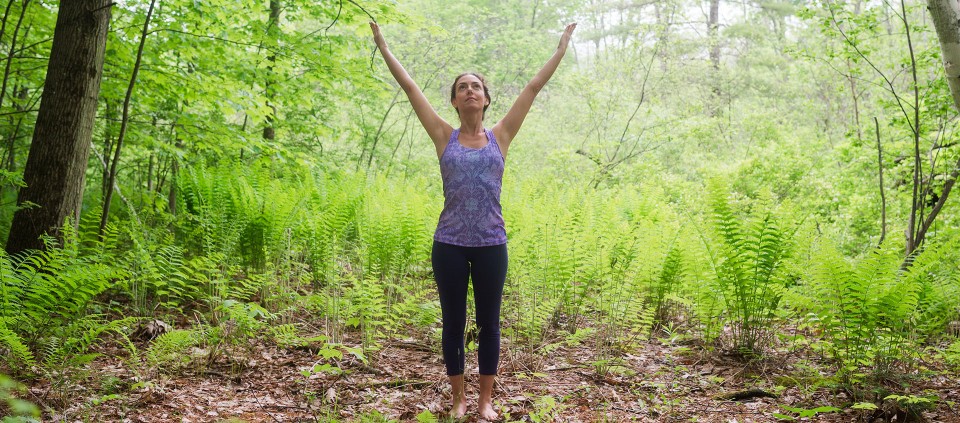Six Nature Meditations for Earth Day (and Every Day)

For thousands of years, yogis have been honoring the earth with their rituals, meditations, and practices—and the planet needs all that good energy now more than ever. Micah Mortali, Director of Outdoor Education and Programming at Kripalu and Dean and Founder of the Kripalu School of Mindful Outdoor Leadership, recommends the following six meditations, which can help you drop into the present moment, contemplate your interconnectedness with the earth and all living beings, and honor the planet—on Earth Day, and on every other day, too.
Air Meditations
Conscious Breathing in Nature
One of the simplest ways to honor the earth is to go outside, where plants are within view, and practice slow, deep conscious breathing, says Micah. “Meditate on the fact that you are inhaling the oxygen that the plants exhale, and they’re inhaling the carbon dioxide that you exhale.”
It can also be profound, he says, to reflect on the fact that “the air we breathe has been cycled on this planet for a couple billion years. You’re inhaling and exhaling the exact same atmosphere that’s always been here.”
The Three-Part Breath
You can also practice Dirgha pranayama, the Three-Part Breath, outdoors. Micah explains: “Sit or stand in a relaxed position with an elongated spine. Fill up the belly with breath, then fill the rib cage, and then allow the breath to fill your upper chest, even your collarbones. Then release the breath in the opposite sequence."
As Ayurvedic consultant and yoga teacher Larissa Hall Carlson observes, this “smooth, wave-like breath” can “anchor the attention in the present.” It can also help you honor the earth, says Micah. “Before I do the practice, I’m not as conscious of the living presence of the earth around me, but after I practice it, I’m acutely aware of the life presences around me, whether they be trees or the grass or insects or other people. Dirgha pranayama awakens something inside us that helps us to recognize our interconnectedness with all life on this planet.”
Fire Meditation
Staring quietly at a fire has a calming effect on the mind, says Micah, because it puts us into a meditative state. As you practice the following meditation, reflect on the fact that “for hundreds of thousands of years, our ancestors gazed at fire every night, while preparing to sleep,” he says. “Gazing at fire is mesmerizing and trance inducing.” It connects us to our earth-honoring ancestors.
Candle Meditation
“Candle meditation is a form of tratak, which means ‘to look or gaze,’” Micah says. “Tratak can be practiced on any object—the ocean, a tree, a cloud—but I find a candle to be one of my favorite focal points.” A campfire can also be a powerful focal point for meditation.
To practice a beginner’s version of tratak, Micah suggests wrapping yourself up in a blanket or cloak, turning out all the other lights in the room, settling onto your cushion, and then letting your gaze rest on the candle flame. The candle is a presence of its own, and you may feel the element of fire almost as a living, breathing companion as you drop into your meditation.
“When we gaze at a flickering flame,” he observes, “our brain begins to shift out of beta brainwave state, which is associated with thinking and alertness, into alpha brainwave state, which corresponds to a relaxed and creative state of mind. Alpha brainwaves then become theta brainwaves, which are associated with meditation, intuition, and the unconscious. When we shift out of our beta/monkey-mind activity and into alpha and theta, the mind becomes relaxed, open, and receptive.”
Water Meditation
Flowing Water Practice
If you have a river, a waterfall, a stream, or a babbling brook nearby, Micah says, you can sit by it, close your eyes, and focus on the sound of the water. The flowing qualities of water help us drop into the present moment. “Like the flickering of a flame, the sound of water can pull our awareness into a meditative state. As you listen to the water, affirm that the flowing water and the water in your body is the same water that’s been on Earth for a couple billion years.”
Earth Meditations
Walking Meditation
There are many forms of walking meditation—try whatever version that resonates with you. Simply walking barefoot outside can be “a powerful way to get in touch with the earth element," says Micah, “because we’re allowing our feet to be in contact with the body of the planet, which we are a part of.”
Outdoor Yoga
Too often, says Micah, “We do yoga on rubber mats in temperature-controlled rooms. You can’t get much more isolated from the earth than that.” Instead, he says, take your yoga practice outside. Turn it into a moving meditation, practicing, if possible, directly on the grass or on a blanket. Contemplate your connection with all living beings as you move in and out of each pose.
All of these practices can help us reflect on our state of interbeing with the planet, and perhaps inspire us to make small or big changes in our lives, Micah says. “There are so many things you can start to do to honor the earth, as you step deeper into an awareness of your interbeing.”
Browse nature and outdoor programs at Kripalu.
© Kripalu Center for Yoga & Health. All rights reserved. To request permission to reprint, please email editor@kripalu.org.